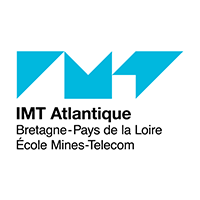
Postdoc in magnonics_Contract 24 months
- On-site
- Brest, Bretagne, France
- Radio-fréquence et micro-ondes
Job description
Internationally recognized generalist engineering school of the IMT (Institut Mines-Télécom), leading French engineering school (Technological University), IMT Atlantique aims to support transitions, train responsible engineers, and use scientific excellence to serve teaching, research and innovation.
Internationally recognized generalist engineering school of the IMT (Institut Mines-Télécom), leading French engineering school (Technological University), IMT Atlantique aims to support transitions, train responsible engineers, and use scientific excellence to serve teaching, research, and innovation.
The proposed postdoc is part of the research activities of the Magnonic team within the Microwave department located in the Brest Campus of IMT Atlantique. The scientific activities of this department are related to the propagation of electromagnetic waves, and concern mainly the modelling, design, construction and characterization of high-frequency signal processing devices, as well as original propagation media for their applications in various communications systems.
The emerging field of magnonics focuses on the transport and processing of information by elementary magnetic excitations called spin waves (or their quanta magnons)[1]. The peculiar wave nature of magnon constitutes of formidable ground for novel wave computing methods, such as spin wave logic, holographic memory, and neuromorphic computing, all of which are essentially interference based methods. Along this global effort to explore the interferometric potential of magnons, we offer at IMT Atlantique in Brest a postdoc position starting in the fall 2024 to study the shaping and the manipulation of spin wave beams at the nanoscale. Recent advances inspired from the concepts of optics demonstrated the focusing or diffracting of spin wave beams in continuous film with properly designed microwave antennas[2]. In parallel, unidirectional transmission of micron-size spin waves beam was achieved very recently using the chiral coupling between the uniform resonance of NiFe nanowires and exchange spin waves in a thin YIG film[3]. In this project, we aim at combining both ideas, and explore configurations of magnetic nanostructures coupled to a continuous thin film that can create interference pattern readily adjustable.
MISSIONS
Under the responsibility of Vincent Vlaminck, this project, in collaboration with the SWING consortium (“Spin waves for advanced signal processing”) of PEPR SPIN, will include several missions:
Undertake micromagnetic simulations to identify the most promising nanomagnet assembly geometries, as well as the most suitable excitation geometries.
Develop nanostructured devices using nanofabrication methods.
Undertake measurement campaigns to demonstrate the feasibility of a magnon interferometer.
ACTIVITIES:
Details of each mission's activities are given below:
1. Micromagnetic simulations will be carried out using MuMax3 software. This numerical study will scroll through the vast range of experimental parameters:
- Nanomagnet dimensions
- Nanomagnet magnetic properties
- Nanomagnet assembly configurations
2. The fabrication of nanostructured devices will involve missions lasting several weeks at the IPCMS STnano platform, and will include:
- Electron lithography
- Thin film deposition
- Static magnetic characterization
3. Measurement campaigns on fabricated samples will be carried out at ITM Atlantique, and will involve:
- Control of thin unprocessed thin films will be done by VNA-FMR measurements.
- Nanostructured devices will be studied by 40GHz broadband propagative spin-wave spectroscopy.
The results of these measurement campaigns will be published in scientific
[1] A. Barman et al., “The 2021 Magnonics Roadmap” J. Phys.: Condens. Matter 33, 413001 (2021).
[2] N. Loayza, et al., “Fresnel diffraction of spin waves”, Phys. Rev. B 98, 144430 (2018); L Temdie, et al., “Probing Spin Wave Diffraction Patterns of Curved Antennas”, Phys. Rev. Appl. 21 (1), 014032.
[3] L. Temdie, et al., “High Wave Vector Non-reciprocal spin Wave Beams”, AIP Advances 13, 025207 (2023).
Job requirements
Minimum education and/or experience required:
We are looking for candidates with a PhD in Physics, preferably in condensed matter, with a strong background in magnetism, and experimental physics.
Essential skills, knowledge and experience:
- A strong background in physical instrumentation
- A meticulous ability to handle delicate experiments
- Ability to perform technical tasks independently
- Proficiency in object-oriented programming for micromagnetic simulation tasks
- Excellent written and oral communication skills.
APPLICATION DOCUMENT
- CV
- cover letter
- recommendation letter
Information request
- Vincent Vlaminck – Associate professor - vincent.vlaminck@imt-atlantique.fr
- For administrative/HR aspects: Fanny BERNARD - fanny.bernard@imt-atlantique.fr
Deadline for application : April 15th, 2025
Start of the contract: 2025, May
Interviews : Ongoing
or
All done!
Your application has been successfully submitted!

